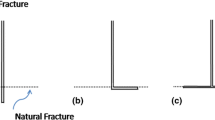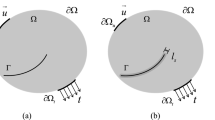Abstract
The unconventional fracture model can simulate complex fracture network propagation in a formation with pre-existing natural fractures. The interaction between hydraulic fracture branches, or stress shadowing effect, could be modeled by 2D or 3D displacement discontinuity method (DDM). In this paper, we concentrate on a hydraulic fracture model that integrates 3D DDM for computing the induced 3D stress field around the propagating hydraulic fractures and incorporates the changes in induced stress into the fracture height calculations and propagation criterion. Examples show that for parallel fractures, the height growth may be promoted or suppressed depending on the relative fracture height. For fractures initiated from different formation layers, the fracture growth into the layer occupied by the other fractures is reduced due to the vertical stress shadowing effect.



















Similar content being viewed by others
References
Adachi J, Siebrits E, Peirce A, Desroches J (2007) Computer simulation of hydraulic fractures. Int J Rock Mech Min Sci 44:739–757
Carter E (1957) Optimum fluid characteristics for fracture extension. In: Howard G, Fact C (eds) Drilling and production practices. American Petroleum Institute, Tulsa, pp 261–270
Cohen CE, Kresse O, Weng X (2015) A new stacked height growth model for hydraulic fracturing simulation. ARMA 15–73, presented at 49th US Rock Mechanics Symposium, San Francisco, CA, 28 June–1 July
Crouch SL, Starfield AM (1983) Boundary element methods in solid mechanics, 1st edn. George Allen & Unwin Ltd, London
Detournay E, Cheng AH-D (1993) Fundamentals of poroelasticity. In: Fairhurst C (ed) Chapter 5 in comprehensive rock engineering: principles, practice and projects, vol II, analysis and design method. Pergamon Press, Oxford, pp 113–171
Fung RL, Vilayakumar S, Cormack DE (1987) Calculation of vertical fracture containment in layered formations. SPE Formation Eval 2(4):518–522. https://doi.org/10.2118/14707-PA
Kresse O, Weng X, Wu R, Gu H (2012) Numerical modeling of hydraulic fracture interaction in complex naturally fractured formations. ARMA12-292. https://doi.org/10.1007/s00603-012-0359-2
Kresse O, Weng X, Chuprakov D, Prioul R, Cohen CE (2013) Effect of flow rate and viscosity on complex fracture development in UFM model. International conference for effective and sustainable hydraulic fracturing, Brisbane, Australia, 20–22 May
Kresse O, Weng X, Mohammadnejad T (2017) Modeling the effect of fracture interference on fracture height growth by coupling 3D Displacement Discontibuity Methid in hydraulic fracture simulator. ARMA17-741, presented at 51st US Rock mechanics/Geomechanics Symposium, San Francisco, CA, 25–28 June
Laubach SE, Olson JE, Gale JFW (2004) Are open fractures necessarily aligned with maximum horizontal stress?. Earth Planet Sci Lett 222 (1):191–195
Mack MG, Warpinski NR (2000) Mechanics of hydraulic fracturing. In: Economides MJ, Nolte KG (eds) Chapter 6, reservoir stimulation, 3rd edn. Wiley, New York
Nolte KG, Economides MJ (eds) (2000) Reservoir stimulation. Wiley, Chichester
Olson JE (2004) Predicting fracture swarms—the influence of subcritical crack growth and the crack-tip process zone on joints spacing in rock. In: Cosgrove JW, Engelder T (eds) The initiation, propagation and arrest of joints and other fractures, vol 231. Geological Soc. Special Publications, London, pp 73–88. https://doi.org/10.1144/gsl.sp.2004.231.01.05
Olson JE (2008) Multi-Fracture propagation modeling: applications to hydraulic fracturing in shales and tight sands. 42nd US Rock Mechanics Symposium and 2nd US-Canada Rock Mechanics Symposium, San Francisco, CA, June 29–July 2
Pollard DD, Segall P (1987) Theoretical displacements and stresses near the fractures in rock: with applications to faults, joints, veins, dikes, and solution surfaces. Fracture Mech Rock. https://doi.org/10.1016/b978-0-12-066266-1.50013-2
Rongved L (1957) Dislocation over a bounded plane area in an infinite solid. J Appl Mech 24:252–254
Salamon MD (1964) Elastic analysis of displacements and stresses induced mining of seam or roof deposits. J S Afr Inst Min Metall Part 4 65:319–338
Shou KJ (1993) A higher order three-dimensional displacement discontinuity method with application to bonded half-space problems. PhD Thesis, University of Minnesota
Shou KJ, Siebrits E, Crouch SL (1997) A higher order displacement discontinuity method for three-dimensional elastostatic problems. Int J Rock Mech Min Sci 34:317–322. https://doi.org/10.1016/s0148-9062(96)00052-6
Sneddon IN (1946) The distribution of stress in the neighborhood of a crack in an elastic solid. Proc Royal Soc A187:229–260. https://doi.org/10.1098/rspa.1946.0077
Wu K (2014) Numerical modeling of complex hydraulic fracture development in unconventional reservoirs. PhD Thesis, University of Texas at Austin, Texas
Wu K, Olson JE (2015) A simplified three-dimensional displacement discontinuity method for multiple fracture simulations. Int J Fract. https://doi.org/10.1007/s10704-015-0023-4
Zhang X, Jeffrey RG, Thiercelin M (2007) Deflection and propagation of fluid-driven fractures at frictional bedding interfaces: a numerical investigation. J Struct Geol 29:396–410
Acknowledgements
The authors would like to thank Schlumberger for permission to publish this paper.
Author information
Authors and Affiliations
Corresponding author
Additional information
Publisher’s Note
Springer Nature remains neutral with regard to jurisdictional claims in published maps and institutional affiliations.
Rights and permissions
About this article
Cite this article
Kresse, O., Weng, X. Numerical Modeling of 3D Hydraulic Fractures Interaction in Complex Naturally Fractured Formations. Rock Mech Rock Eng 51, 3863–3881 (2018). https://doi.org/10.1007/s00603-018-1539-5
Received:
Accepted:
Published:
Issue Date:
DOI: https://doi.org/10.1007/s00603-018-1539-5




